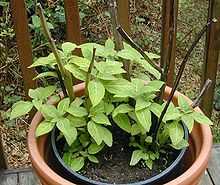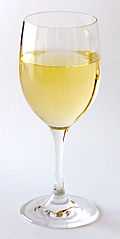Legal intoxicant
Legal intoxicants, also known as legal highs, are intoxicating drugs which are not prohibited by drug laws. The most commonly used intoxicant is alcohol but many others are used including native intoxicating plants historically used by indigenous cultures and modern chemical intoxicating substances that have not been defined as illegal.
Stimulants
Mephedrone
Mephedrone a dopaminergic, serotonergic, and adrenergic stimulant. It is legal to possess in some countries.
Caffeine
A mild stimulant used most commonly via coffee, tea, and soft drinks also similar to cocaine with the exception of lacking in euphoria.
Nicotine
Stimulant drug most commonly found in tobacco products.
Ephedrine
Ephedrine is a sympathomimetic amine that is an adrenergic receptor agonist and is used as a stimulant. Although it is legal to possess and to purchase as an over-the-counter drug in the United States, the US Food and Drug Administration banned its sale as an herbal supplement in 2004.[1]
Betel
Chewed nut popular in Asia.
Psychedelics
Hawaiian baby woodrose
Hawaiian Baby Woodrose (Argyreia nervosa) is a perennial climbing vine, also known as Elephant Creeper and Woolly Morning Glory. The seeds of the plant contain the alkaloid LSA (ergine), which is a chemical analog of LSD. As such, they are sometimes used as a "legal" psychedelic. Ipomea Morning Glory seeds also contain LSA, but at a lower level. However, as LSA is a DEA Schedule III substance in the USA, the ingestion of LSA-containing plants could be prosecutable. In most countries in the EU however, it is unregulated.
San Pedro cactus
San Pedro cactus contains mescaline which is illegal in most countries when isolated. This is the same active substance in the peyote cactus which can only be used legally by some native American tribes which have a history of using the plant. San Pedro can be bought and sold and the tissues can also be bought (primary container) from online shops. In many countries, however, it is a serious crime to buy, sell or consume the cactus for reasons of intoxication (any other reason besides ornamental use), because the active ingredient in the cactus, mescaline, is a scheduled substance in those countries.
Peruvian torch and Peyote are both very similar to San Pedro, both being cacti that contain mescaline, and are used as entheogens.
Anadenanthera colubrina and A. peregrina
DMT, 5-MeO-DMT, and bufotenin.
Psychotria viridis
Contains DMT and is the principle psychedelic ingredient in the Ayahuasca brew.
Mimosa hostilis
Contains DMT.
Colorado River toad
The venom of the toad species Bufo alvarius contains 5-MeO-DMT and bufotenin, which is smoked once extracted from the toad. Several other toad species in the Bufo genus and a few other toad genera contain 5-MeO-DMT and bufotenin, but not in noticeably psychoactive quantities.[2]
Synthetic cannabinoids
These substances are most commonly found in incense products most commonly used for smoking, and are legal in most (but not all) circumstances. Some commonly known names are Rasta Weed, Spice and Herbal Incense. The legality of synthetic cannabinoids vary between different states and countries. Some of them are as potent (if not more) than THC, the main psychoactive ingredient found in marijuana. Herbal mixes have varying effects depending on the cannabinoids in the mix and the amount of those. Each one of t Since synthetic cannabinoids is a relatively new drug there is little (if any at all) research on effects from longer periods of use. Mainly became popular because governments worldwide can't manage to ban the chemicals for juridical reasons in the same pace as they are discovered, but also because almost no knowledge and material (except the active substance) is needed to dilute the substance into more easily dosable amounts. A common strength on the smokable final product is 2 grams of the cannabinoid on 100 grams of smoking material, usually solved in Acetone and sprayed over the herb. Of course, this may vary depending on if it's for commercial distribution or personal use.
Dissociatives
Salvia divinorum

Salvia divinorum is a psychoactive plant which can induce dissociative effects and hallucinations which may last anywhere from a few seconds to several minutes. It is commonly reported that there is a threshold dose, below which the plant likely won't produce any effects in the user, so a high dose is sometimes required. It has been linked to long usage as an entheogen by the indigenous Mazatec shamans for healing during spirit journeys. Salvia divinorum remains legal in most countries and, within the United States, is legal in the majority of states. There have not been many publicized prosecutions of individuals violating anti-salvia laws in the few countries and states in which it has been made illegal. The effects are very powerful and can be quite terrifying to the user.
DXM
Dextromethorphan is an antitussive (cough-suppressant) drug found in many over-the-counter cold and cough medicines. When taken at doses higher than are medically recommended, dextromethorphan is classified as a dissociative hallucinogenic drug. It can produce effects similar to those of the controlled substances PCP and ketamine.
Nitrous oxide
Also known as "Laughing Gas". One of the most common inhalants, nitrous oxide is also known as "whippits", after the common brand-name of the charging cartridges used in food service whipped-cream dispensers, or NOS after the brand-name Nitrous Oxide Systems which produce Nitrous Oxide-based power enhancement systems for internal combustion engines (commonly used by drag racers). Most inhalants are directly neurotoxic, except for nitrous, amyl nitrate, and ether to an extent. Although nitrous depletes vitamin B12 from the body, this isn't a concern for the occasional user since most animal foods have the vitamin, particularly beef, lamb, and pork. However, chronic use can cause a severe B12 deficiency, which can cause psychological, neurological, and other physiological harm. Nitrous Oxide is commonly administered by using a charging cartridge and whipped cream dispenser to inflate a balloon, the contents of which is then inhaled in and out until the balloon is empty. The 'high' can be extremely intense, often causing the user to laugh uncontrollably and producing a dissociative ( or 'spaced out') sensation, but this typically lasts no more than 2 minutes.
Methoxetamine
Methoxetamine is a near chemical analog of ketamine and PCP. Its use was first publicly reported in 2010. Methoxetamine's effects are described by some as similar to ketamine or high-dose DXM, while others report not finding it similar to those substances.[citation needed]
Deliriants
Diphenhydramine and dimenhydrinate
Diphenhydramine is an antihistamine and a sedative and is available over-the-counter for allergy relief and for use as a sleep aid and dimenhydrinate is available over-the-counter for alleviation of motion sickness. Recreational users take many times (>250 mg) the therapeutic dose to achieve a state of delusional delirium.
Datura
Datura species (especially Datura stramonium, commonly known as Jimson weed) are common poisonous weeds in the Solanaceae (nightshade) family. They contain tropane alkaloids that are sometimes used as a hallucinogen. The active ingredients are atropine, hyoscyamine and scopolamine which are classified as deliriants. It can be smoked, eaten or made into a tea. The seeds are extremely potent and should be avoided.
Datura use has been associated with hospital visits and death in cases of overdose, and it has earned a reputation of being a rather dangerous substance due to the possible loss of control over ones self.[citation needed]
Nutmeg
Nutmeg contains myristicin and elemicin which were both considered psychoactive chemicals. Myristicin, along with being a deliriant, is also a weak monoamine oxidase inhibitor.[3]
Depressants
Ethanol

Alcoholic beverages contain the psychoactive drug, ethanol (grain alcohol), with a depressant effect. They are legal in most of the world (except some Muslim countries), although their use is restricted almost everywhere. Alcohol is considered a legal class A drug in most jurisdictions (Bufton, 2007).
Kava (Kavalactone)

Kava (Piper methysticum) is an ancient crop of the western Pacific. The onset of a moderate potency kava drink is 20–30 minutes, with effects usually lasting for two hours but effects can be felt up to eight hours after ingestion.[citation needed]
Diethyl ether
A solvent sedative used medically as an anesthetic and recreationally for its effects similar to alcohol. It is more potent than alcohol and has less "hang over" effect. It is generally legal due its wide use as lab chemical and solvent for industry.
Inhalants
Inhalants are commonly used in many parts of the world for their powerful but short lived psychoactive effects; the most common group to use inhalants are young people.[citation needed]
Nitrites
Also known as Poppers. Nitrites include Amyl, Butyl, Methyl, Isopropol, Isobutal, Ethyl, Alkyl and the newer "US" formula containing Cyclohexyl Nitrite (the only nitrite to not currently require a prescription). Originally used as anti-anginal heart medication to lower blood pressure and even as an antidote to Cyanide Poisoning. Products are advertised as odorisers, leather cleaner and video head cleaner. Combination with Nitrous Oxide is referred to as 'Space Surfing' because of the intense synergistic effect of the two inhalants.
Opioids
An opioid is a chemical substance that has a morphine-like action in the body. Most opioids are not legal for over the counter purchase; However, some products that are legal (poppy seeds, poppy pods, and poppy plant material) contain morphine, codeine, and other analgesic opiates. Many of these products may be purchased legally but it is illegal to use them for anything other than cooking and decorative purposes. Codeine can be purchased over the counter in some jurisdictions, but it's usually mixed with Paracetamol to discourage abuse. The paracetamol, however, can be removed fairly easily by manipulation of the different solubility of paracetamol and codeine in cold water.[4]
Kratom is a legal opioid.
See also
References
- ↑ Federal Register: February 11, 2004 (Volume 69, Number 28): Final Rule Declaring Dietary Supplements Containing Ephedrine Alkaloids Adulterated Because They Present an Unreasonable Risk; Final Rule
- ↑ Erowid Psychoactive Toad Vault
- ↑ Hallucinogens
- ↑ http://en.wikipedia.org/wiki/Codeine#Controlled_substance http://www.erowid.org/pharms/codeine/codeine_law.shtml